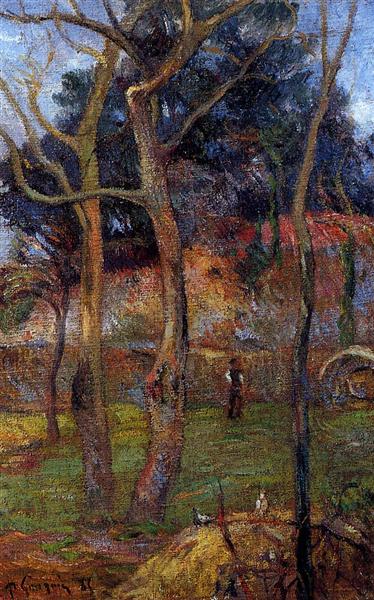Description
Paul Gauguin's "naked trees", painted in 1885, offers a deep look at the artist's connection with landscape and nature transitions. In this work, Gauguin moves away from the romantic and idealized representations of the trees, instead opting for a more crude and almost melancholic interpretation of form and space. The composition is dominated by a group of naked tree trunks, which stand robust in the center of the work, its dry branches extending in diverse directions, creating a feeling of instability and desolation.
The trees, stripped of their foliage, seem to reflect a stage of decomposition in the natural life cycle, symbolizing the imminent change that winter brings. The color palette used by Gauguin is remarkably sober; Earth, ocher and gray tones predominate that evoke a gloomy atmosphere. This use of color departs from the brilliance that would characterize his posterior Goyesca work, evidencing a time when the artist still explored his style and relationship with nature. The contrast between the dark trunks and the grayish sky accentuates the sensation of vacuum and loneliness inherent in the scene.
There are no human characters in the composition, which leaves the viewer to focus completely on the interaction between trees and the environment. However, this emptiness also invites contemplation, suggesting a certain fragility in life and the passage of time. Through this work, Gauguin is involved in an introspective exploration, questioning the relationship between human beings and nature. This facet of his work can be in line with the nascent ideas of symbolism, a movement that would begin to gain ground in the artistic scene of the late nineteenth century, in which artists sought to capture the emotions and states of the soul through The visual representation.
The influence of impressionism is perceived in the brushstroke and in the attention to light, although Gauguin unchecks this current by preferring the most gloomy issues and emotional explorations. "Naked trees" can be seen as a precursor to its more intense and idiosyncratic subsequent explorations that would characterize their work in Tahiti. The work not only reflects a stage in Gauguin's artistic evolution, but also offers us a look at his thoughts on the relationship between man, nature and the inevitable passage of time.
In conclusion, "naked trees" is a painting that, although simple in its composition, suggests significant emotional complexity. The absence of human figures underlines the introspection of the artist and the dialogue that establishes with nature, pointing towards a sensitivity that rescues beauty even in desolation. This work not only reveals Gauguin's talent as an observer of nature, but also highlights its ability to capture the essence of transition and impermanence in the natural world.
KUADROS ©, a famous paint on your wall.
Hand-made oil painting reproductions, with the quality of professional artists and the distinctive seal of KUADROS ©.
Reproduction service paintings With a guarantee of satisfaction. If you are not completely satisfied with the replica of your painting, we refund your money 100%.

